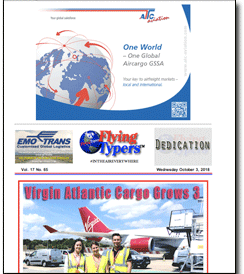
Monday September 24 marked the beginning of
a holiday for many in China, as the Mid-Autumn Festival, also known as
the Mooncake Festival or Lantern Festival, closed many businesses to celebrate
a family-driven tradition. One of the most important festivals of the
year for Chinese people around the world, the Mooncake Festival dates
back over 3,500 years.
 Richard
Malkin, the first air cargo reporter at the Berlin Airlift of 1948. Richard
Malkin, the first air cargo reporter at the Berlin Airlift of 1948.
(Editor’s Note) Our headline Octember is no
typo. My good friend, the late Editor Emeritus of this publication, Richard
Malkin would never let October go by without referring to this month as
“Octember”
I asked him at breakfast, (his favorite meal) as we sat inside the Omega
Diner near his home in Floral Park, New York, when he was 104 years old,
where did that word blending come from and he replied:
“For air cargo, the peak season of October and November seem to
come and go each year in a blur, thus Octember seems to neatly sum this
time up.”
Richard Malkin, who made it until July 2017, may have left this dimension
but is never out of mind at FlyingTypers. (G)
Another Opening
Another Show
Air freight rates reached yearly highs at
the start of October and, although IATA remains pessimistic, most indications
now point towards a healthy 2018 peak season followed by a strong lead-in
to January’s Chinese New Year.
 Peak
Pumping Traffic Peak
Pumping Traffic
Paul Tsui, managing director of forwarding
and logistics operator Janel Group, told FlyingTypers that early indicators
suggested the 2018 peak season was already building and would continue
through to Chinese New Year. He also said higher U.S. tariffs on Chinese
exports due for implementation on January 1 would, based on the experience
of previous Sino-U.S. tariff deadlines, also give rates and demand a bump
at the end of the year.
When Tight
Is Right
At the start of October U.S.-based forwarder
Flexport, meanwhile, reported that space from China to the U.S. “remains
tight and rates are high”. Ex-Hong Kong market demand was reported
as “high” with space getting tighter and rates continuing
to rise, while ex-Vietnam market, demand was “extremely high”
and the forwarder warned that shipments with a tight deadline should be
booked as express.
“Aside from standard peak season effect,
the threat of a new round of tariffs has motivated many to move up shipments,”
said Flexport. “Europe’s peak’s season is likely to
begin soon, as well.”
TAC Indexes
Rates
Based on rate movements, it already has.
Hong Kong – Europe and Hong -North America rates reached 2018 highs
of $3.04 per kilo and $4.7 per kilo, respectively, on October 1, according
to TAC Index.
IATA Capacity
Up
A peak season surge will give air freight
stakeholders a timely boost after a year of erratic growth. The International
Air Transport Association (IATA) said demand, measured in freight ton
kilometers rose 2.3% year-on-year in August 2018. “This pace of
growth was unchanged from the previous month but was less than half the
five-year average growth rate of 5.1%,” it reported.
IATA also noted that freight capacity, measured
in available freight ton kilometers, grew by 4.5% year-on-year in August,
the sixth month in a row that capacity growth outstripped demand growth,
although yields “appear to be holding up”.
Growth, according to IATA, is being supported
by a number of factors including buoyant consumer confidence, an upturn
in the global investment cycle and growing international e-commerce.
 However,
even as demand and rates showed positive signs, IATA was surprisingly
downbeat on air cargo markets with its latest report noting that export
order books in Europe, China, Japan and Korea had fallen in recent months. However,
even as demand and rates showed positive signs, IATA was surprisingly
downbeat on air cargo markets with its latest report noting that export
order books in Europe, China, Japan and Korea had fallen in recent months.
“Order books are weakening and supply
delivery times are lengthening,” said Alexandre de Juniac, IATA's
Director General and CEO. “And the growing trade tensions are a
specter over the industry. The early focus of tariffs was not on products
typically carried by air. But as the list of tariffs grows so does the
air cargo industry’s vulnerability. And, we can expect souring trading
relations to eventually impact business travel. There are no winners in
trade wars.”
To Each Their
Own
IATA’s pessimism was not reflected
in Asia, although it should be noted that the new export orders sub-index
China’s official manufacturing Purchasing Managers Index fell dramatically
to 48.0 in September from 49.4 in August, implying rising uncertainty
on the export outlook.
 The
Association of Asia Pacific Airlines recorded growth in international
air cargo demand of 4.2% year-on-year in August and up 4.8% over the first
eight months of 2018, while Hong Kong International Airport, the world’s
largest hub for international freight, handled 431,000 tonnes of cargo
and airmail last month, up 2.4% year-on-year, with traffic to and from
North America and Southeast Asia posting the most significant growth. The
Association of Asia Pacific Airlines recorded growth in international
air cargo demand of 4.2% year-on-year in August and up 4.8% over the first
eight months of 2018, while Hong Kong International Airport, the world’s
largest hub for international freight, handled 431,000 tonnes of cargo
and airmail last month, up 2.4% year-on-year, with traffic to and from
North America and Southeast Asia posting the most significant growth.
Andrew Herdman, AAPA Director General, said
growth rates had “moderated after the strong surge we saw last year”.
He was optimistic moving forward although, like IATA, he warned that demand
could be hurt by trade wars.
“The ongoing expansion in the global
economy is sustaining high levels of consumer confidence which should
continue to support further growth in both leisure and business travel
markets,” he added.
“Air cargo demand remains relatively
firm moving into the peak season, even though growth rates have moderated.
The escalation in protectionist rhetoric and the imposition of new tariffs
has so far had little real impact on trade flows but adds an element of
uncertainty for businesses reliant on integrated global supply chains.”
SkyKing
|




 Vol.
17 No. 64
Vol.
17 No. 64 Vol.
17 No. 65
Vol.
17 No. 65